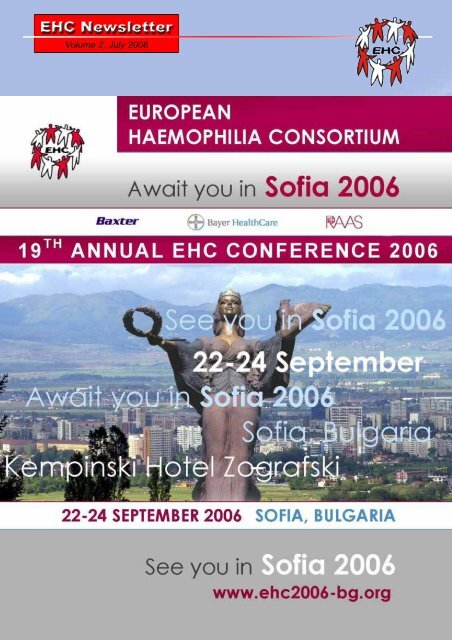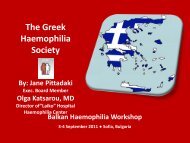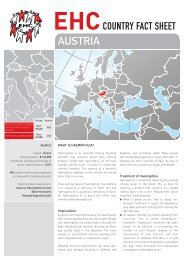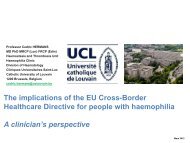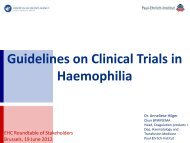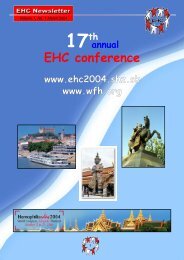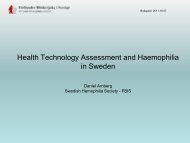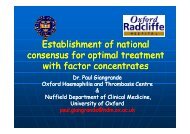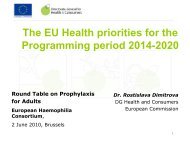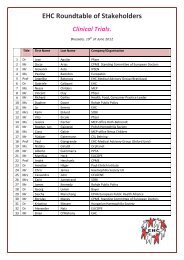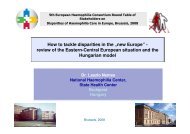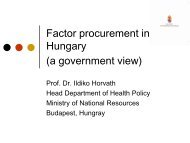Volume 2, July 2006 - EHC
Volume 2, July 2006 - EHC
Volume 2, July 2006 - EHC
- No tags were found...
You also want an ePaper? Increase the reach of your titles
YUMPU automatically turns print PDFs into web optimized ePapers that Google loves.
<strong>Volume</strong> 2, <strong>July</strong> <strong>2006</strong>1
<strong>Volume</strong> 2, <strong>July</strong> <strong>2006</strong>Chairman’s reportDear reader of the <strong>EHC</strong>-Newsletter, dear friend of theEuropean HaemophiliaConsortium !Our Members Meeting inVancouver was one of the majorchallenges this year, and all of youwho attend know why, and howcomplicated the situation of a volunteerpatient- organisationsumbrella organisation can be.Therefor we are very happy tohave completed the new <strong>EHC</strong>- Statutes in Englishand French (according to Belgium law) and translatedthem into Russian for our friends in Centraland Eastern Europe.It is a big honour and personal pleasure to congratulateour distinguished friends and supporters,the host of the <strong>EHC</strong>- Annual Conference 2004,Mrs. Dr. Angelika BATOROVA to the election as amedical member, and my predecessor as a chairmanof <strong>EHC</strong>´s Steering Committee, Mr. GordonCLARKE to his re- election as a lay member of theExecutive Committee of the World Federation ofHemophilia.Angelika is known as a hard- working and veryseasoned personand we are veryproud and happy“that she made it”,Gordon, despite ofhis actual physicalrestrictions, is a wellknown, acknowledgedchampion inpatient representation.The whole SteeringCommittee wants toexpress the deeplyfelt congratulations to this importantfunctions and congratulatesand thanks all other elected volunteersfor their engagement inthe improvement of HaemophiliaCare all over the world.Unfortunately there are still bigdifferences and intentions withinthe Russian Haemophilia Society,President Yuri Zhulyov decidednot to host the <strong>EHC</strong>- AnnualAssembly in 2008 despite thepresentation of the St.Petersburgchapter, and we are again looking for a hostcountryin this part of Europe.The <strong>EHC</strong>s website (www.ehc.eu, www.hemophilia.eu,www.haemophilia.eu, www.hemophilia.eu,www.hemophilie.eu) to be finalised in this daysand we will be “on air” very soon after the acceptionof the new Statutes by the MembersAssembly in Sofia. Wyeth- France was a littlefaster (minutes) than we withwww.hemophilie.eu, but Dr.Ralph Carter fromWyeth promised to intervene for us to get thisdomain “back”.Again it is to thank Edmond SECQ, Jean Houssiauand the Belgium Haemophilia Society for theirintensive input anddedication.The 19th AnnualAssembly, Sofia,Bulgaria, September22nd to 24thThe SecondAnnouncement willbe distributed aswell as posted at theConference- website- www.ehc<strong>2006</strong>-bg.org please regis-3
<strong>Volume</strong> 2, <strong>July</strong> <strong>2006</strong>ter as soon as possible to support the organisingteam to do a good job. We found numerous sponsors,they are listed at the website and in theannouncements, and we want to thank these 3Gold Sponsors, 3 Silver Sponsors and 4 additonalsponsors and supporters very much.For the first time we had not enough opportunitiesfor all of them, so we decided to offer anadditional sightseeing tour and a satellite symposium,where in addition to the participants of theHaemophilia Community some 200 doctors andtechnicians, specialised in general haematology/oncology, immunology, will be invited.In this issue you will find an obituary in honor ofMr. Pekka Heikkilä, announcements and numerousarticles and reports. I want to thank all of theauthors for their tremendous efforts and supportof this issue; the next <strong>EHC</strong>- Newsletter will be distributedearly September.I remain with my best wishes, hoping to meetingyou in Sofia,Hubert K.Hartlchairmanhartl@bluter.atReport of the elections during the General AssemblyMay 26 of the World Federation of Hemophilia.Four positions are up for election; 2 medical members and 2 lay members.The persones ho are nominated past the nominatition process of the WFHMedical Member Candidates.Magdy EL Ekiaby 14 votesHubert K. Hartl24 votesRaul Perez Bianco 20 votesAlok Srivastava29 votesNigel Key41 votesAngelika Batorova 31 votesLay Member Candidates:Gordon ClarkeMohamed Aris HashimCesar Garrido51 votes48 votes53 votesThe <strong>EHC</strong> congratulete the winners: Medical Nigel Key North America and Anglika Batorova EastEurope. Lay members Gordon Clarke West Europe and Cesra Garrido South Amirca.Glad we are that we have two reprecentatives from Europe in the board of the WFH.The election of who organize the 2010 world congress is won by Argentina with 55 votes againstFrance with 22 votes. The <strong>EHC</strong> congratulate Argentina with there victory.4Ad Veldhuizen
<strong>Volume</strong> 2, <strong>July</strong> <strong>2006</strong>New Insurance Scheme for Personswith HaemophiliaOn <strong>July</strong> 6th, the Irish Senate approved and passedinto law a novel insurance scheme which willbenefit persons with Haemophilia who wereinfected with HIV and/or Hepatitis C. The law wasthe result of 3 years of negotiation and discussionbetween the Irish Department of Health andthe 4 organisations, including the IrishHaemophilia Society which represent those whowere infected via the administration of blood orblood products. (The other organisations representthose infected via anti-d, Blood and Dialysisrespectively)The principle of the scheme is that no eligibleperson should have to pay a life insurance premiumwhich is higher than that which would becharged to a person of the same age and genderwho does not have HIV or Hepatitis C. Essentially,the individual will apply for insurance to one of apanel of insurance companies. A premium will becharged by the company. The individual will paythe portion of the premium which would apply toa perfectly healthy person of the same age andgender. The scheme administrator, on behalf ofthe Government, will pay the balance of the premiumincluding any loading applied by the insurancecompany for HIV, Hepatitis C, haemophiliaor any other existing medical condition. If anindividual is deemed "uninsurable" by the insurancecompanies, they will still be able to utilisethe scheme at the normally applicable premiumwith the Government assuming the insurance riskin full. Joint policies will also be possible withspouses or with partners where the relationshipis of at least 3 years duration. Life insurancecover will be available up to the age of 75 years.The scheme will provide access to life insurance,mortgage protection insurance and travelinsurance. Each individual will be allowed to availof life insurance up to a maximum of €420,000 orup to 7 times annual salary to a maximum of €525,000. In addition, each individual will be allowedto avail of mortgage insurance up to a maximumof €492,000 for the purchase, change, alterationor refurbishment of their principal residenceand up to €100,000 for any other propertythey own. All of these amounts will be index linkedto inflation. Work is currently underway todefine the parameters for the provision of travelinsurance.Following enactment of the law in <strong>July</strong> by boththe Dail (parliament) and the upper house(Senate), the Minister of Health will draft regulationsgiving effect to the provisions and a schemeadministrator will be appointed.This legislation, which has been the focus ofmuch work and effort by the 4 organisations andour legal teams over the past number of years,will provide the security of life insurance andmortgage insurance to those for whom such insurancewas previously prohibitively expensive orimpossible to obtain. It will allow persons withHaemophilia to make proper and adequate provisionfor their families.The insurance loadings (additional premiums)which will be applied by the insurance companieswill be paid by the scheme administrator onbehalf of the Government. The quantum of suchloadings will, I believe, be of interest to peoplewith haemophilia in many countries and, if possible,this information will be shared when available.Any person who would like a PDF copy of thelegislation should contact:Brian O’ Mahony at brianihs@eircom.netBrian O’ MahonyIrish Haemophilia Society13th <strong>July</strong>, <strong>2006</strong>5
<strong>Volume</strong> 2, <strong>July</strong> <strong>2006</strong>The National Congress of the FrenchHaemophilia Association (AFH)June 10-11, <strong>2006</strong> – La Grande Motte (Montpellier)This yearly congress started Friday in the kindheartedholidays centre “l’Ensoleillade”, and thesun took part of this event so breakfast, dinnerand even some commission meetings took placeoutside.I was invited to give an overview of haemophiliacare in Europe (the presentation Hubert Hartlhas given in the EU Parliament during the awarenesscampaign, Brussels January 12, <strong>2006</strong>), andmy Belgian colleague Patrick Finders-Binge presentedthe brand new CD-Rom about auto treatment.The principal items, out of the General assembly,were:- the organisation of the regional treatment centres(CRTH)- the urgencies;- the role of the co-ordinating nurse;- physiotherapy and haemophilia;- national registry haemophilia “FranceCoag”, byDr. Jean Donadieu; this programme will also,before long, be applicable in Belgium. It is largelyinspired by the UK programme;- relations between French treatment centresand foreign centres (twinning programmes) byPr Jean-François Schved;- the future and projects between AFH andCRTH, by Pr. Jean-François Schved (President ofFFCRSH) and Mr. Norbert Ferré, President ofAFH.Once again I was conquered by the perfect organisationand timing of the French. It was really àsuccessful event and it is with great pleasure thatI congratulate Norbert Ferré and his team.As France is a big country they are workingwith 20 regional committee (all volunteers). AFHhas a staff of 3 paid employees in Paris.They have different commissions : ‘youngsters’;‘family’ and ‘women and haemophilia’; a scientificadvice group; a cell consisting of three specialisedvolunteers observing the scientific topicality;youth camps and stages to practice self treatment;the biannual scientific prize HenriChaigneau who is delivered at each WorldCongress of Haemophilia.; a network of lawyersassisting members in their claims for HIV andHCV compensation; different brochures and ofcourse their quarterly remarkable bulletin.Norbert Ferré was re-elected as President andMartial De Haro as Vice-president foreign connections.With Norbert on the helm his team will enthusiasticallycontinue to serve haemophiliacs in Franceand abroad.Edmond Secq, member SC <strong>EHC</strong>editorial board:steering comitee of the European Haemophilia Consortium, c/o Austrian Hemophilia Society,SHZ – AidsHilfeHaus, Mariahilfer Gürtel 4, A-1060 Vienna,E-Mail: ehc@bluter.at, Vol. 2 <strong>2006</strong>,all rights reserved, copyright <strong>EHC</strong>, <strong>2006</strong>authors of this issue:Gabriela Böhm, Gabriele Calizzani, Hubert K Hartl, Brian O´Mahony,Jane Pittadaki, David Pouliot Thomas Schindl, Uwe Schlenkrich, Edmond Secq,Zbigniew Sendulka, David Silva, Margret Unwin, Ad Veldhuizen, Yuri Zhulyov6
<strong>Volume</strong> 2, <strong>July</strong> <strong>2006</strong>Standpoints concerning the administrationof lower doses of FVIII !Prof. Dr. Carol K. Kasper, MD, Orthopaedic Hospital, Los Angeles ‘emeritus’.Carol Kasper was during many years the Vice-President Medical of the World Federation ofHaemophilia. She is praised as a great scientistand has fully contributed to better haemophiliacare world wide but especially in Central- andSouth America. She is ‘obsessed to know moreabout haemophilia’ and besides this a great ladywith class and culture. To meet her is always ashared moment of solidarity and enrichment ofknowledgeI am, with so many others, an absolute fan ofher ’hemophilia bulletin’, and let us hope thateven as a emeritus she will continue to publish it.Her newsletter is going mainly on comments ofthe latest haemophilia innovations and presentationsduring congresses and symposia.I regularly reproduce some of her wise commentsin Forum. She has a remarkable gift forteaching. Her way to put accents on standpointsgives a much more better insight.In her newsletter November 2005 , GlobalForum she his giving her standpoint on dosageand I mean, that with her experience, her voicemust be heard.Its about ‘objective studies of dosage’ whodespite the high cost of concentrate are rare.Alok Srivastava of Vellore, India, found 13small studies, all performed more than 20 yearsago, describing lower doses than are now in commonuse. Analysis of thrombin generation assaysshows a near normal response at about 30% plasmaFVIII levels. Dr. Srivastava reviewed Dutchdata on dosage and outcome from the 1970’ to90’. As more patients got onto the home programand onto prophylaxis, and as the weekly dose forprophylaxis doubled over the decade, the numberof joint hemorrhages fell.Dr. Srivastava argues that whereas increasingthe yearly consumption of concentrate doesreduce hemorrhages and joint damage, one neednot despair if those cannot be initiated in poorercountries.An intermediate level of factor replacement,1000-2000 units/kg/year, may serve to preservefunctional independence. (That dosage level isthe current target in Brazil). For surgical operationsin Vellore, Dr. Srivastava uses a pre-operativedose that raises plasma FVIII level to 80-100%and post operative doses maintaining a throughlevel of 20-40%. His dosage scheme is similar tomine with early (1968-1970’s) elective orthopaedicsurgeries in Los Angeles. I agree that dosagehas escalated in the western world without evidencethat higher doses are necessary or advantageous.I suspect that very good results could beobtained with more modest doses. We shouldmake optimal use of less-expensive agents:physiotherapy as prophylaxis, DDAVP whereappropriate, local hemostatic agents in surgeryand tooth extraction, anti-fibrinolytic agents intooth extraction.Good management with lesser doses of concentraterequires careful attention from someonedevoted and expert. That may be the problem.Where the cost of concentrate is not an issue, it’seasy to just give higher doses and ignore thealternatives.A man in Vellore might feel discriminatedbecause he is receiving lower doses, when in reality,he is being managed much more scientificallythan a man in Los Angeles.Wouldn’t it be useful to work on a Europeanscheme because there are enormous differenceseven in the EU. From the 7,5 IU FVIII per capita inSweden to +- one IU FVIII per capita in Estonia,Bulgaria and Rumania.During the FWH Congress in Vancouver, Prof. E.Berntorp, the well known Swedish specialistabout prophylaxis, talked about a futur programlowering dosage FVIII ???Wait and see.Many thanks to Professor Dr. Carol K. Kasper –www.carolkasper.comEdmond Secq7
<strong>Volume</strong> 2, <strong>July</strong> <strong>2006</strong>MORE LOBBYINGA REPORT OF DAVID SILVA, SPAINRecombinant products in Western Europe hasgrown to currently become the most used treatmentfor people with hemophilia. Despite thisfact, come countries like Spain, with establishedeconomies which could perfectly face the highcosts, still have low rates of recombinant productsuse comparing to the plasmatic ones.This is the reason why the Spanish Federationof Hemophilia decided to start working hardduring this year in order to increase the use ofrecombinant products in the Spanish TreatmentCentres. This is such a difficult task because theNational Health Services were transferred someyears ago to the Regional Governments, so theseare the ones who decide how they spend theirbudgets. According to that, there were no pointthe Spanish Federation of Hemophilia to wasteits time lobbying the National Ministry of Healthbut it should pay attention to the RegionalHealth Services. And that is what is going on.At the beginning of June, a training course forour chapters was organized so that the membersof the boards were able to set up and maintain alobbying campaign in each region. Fortunately,we could count on Brian O’Mahoney, a great specialistin lobbying tasks, who came to Madrid toshare his experiences in this matter with all of us.The first morning we made an overview of ourNational Health System, paying attention to allthe stakeholders we should contact in eachregion to transmit our aims and our demands.We also had the opportunity to learn a little bitabout the Media work and how we can use themin a right way. Then, we revised all the lobbyingcampaigns that the former boards had to developin order to get different compensations (HIV, HCV,etc…). They shared their experiences with all theparticipants and we could checked that theirknowledge and experience are still very importantto go on lobbying so that we can get the bestfor people with hemophilia. In the afternoon,Brian explained the main points to develop a lobbyingcampaign and then he proposed a casestudy to work in.Next day, after having all that information inour brains, we had a brainstorming session wherewe could design all together the campaign thatwe are running now. We’ll see how it finish…Mr. Pekka Heikkilä 1.7.1960 – 14.1.<strong>2006</strong>Pekka was born in Helsinki, Finland.After graduated from high school on age of twenty he worked as a professional photographer andsalesman for photographing equipment. In this work he photographed for commercial purposes tocompanies, but he also took portrait photos in studio.Pekka had to change his profession at beginning of 90’s because job as a photographer strained too much hislegs. At this time his hobby became a profession. He has been interested in computers for a long time, and now here-educated himself to an it-professional.He worked several years in major finnish industrial company, Hackman Metos, as a network support specialist.Pekka became member of board of The Finnish Hemophilia Society at the beginning of 1999, but before that hehas already participated in society’s work for many years. He was member of board until his death. In this job hewas in major role for participating in international meetings and congresses and keeping up society’s foreign contacts.Pekka was also an individual member of WFH and a member of Irish Haemophilia Society. His openheartedand social disposition bring him many friends from the domestic and international hemophilia community.Pekka’s most loved hobby were the two dogs owned by him and his ex-wife. He was also interested in pistol shootingand computers, even after them became his profession. Photographing included also in his hobbies. Sailing wasnot actually his hobby, but some most memorable time he spent in the Mediterranean Sea on his friend’s boat.8
<strong>Volume</strong> 2, <strong>July</strong> <strong>2006</strong>Expert meeting on factor VIII productsand inhibitor developmentThe occurrence of antibodies against factor VIIIor IX is the major treatment complication andthe major safety risk for haemophilia A or Bpatients nowadays. But what are the reasons ofthe development of an inhibitor, what is theimpact of the clotting factor and what is the bestway to conduct a study about inhibitors. Aboutthese issues discussed researchers, physicians,representatives of health authorities, industryand representatives of the WFH and <strong>EHC</strong> withexperts from the EMEA in London.While the occurrence of inhibitors in previouslyuntreated patients (PUPs) should be seen as anatural reaction to a foreign protein linked topatient related factors, the development of inhibitorsin multi-transfused and stable previouslytreated patients (PTPs) may reflect neo-antigenicity/ neoantigenic epitopes of the product. TheEMEA stated that “Currently it is not knownwhether recombinant FVIII products are moreimmunogenic than plasma derived FVIII andwhether there are differences between recombinantproducts in their immunogenicity”.About 25-30% of previously untreated patients(PUP) with haemophilia A and about 4 % with haemophiliaB develop an inhibitor. This means forthe patient:- Inhibitors sharply reduce the efficacy of haemostatictreatment- It makes prophylaxis impossible- It causes additional and more severe bleedingepisodes- It reduces a patients Quality of Life significantly- The managing of inhibitors is very costlyRisk factors for the development of FVIII inhibitorsin PUPsWe must distinguish between genetic and environmentalfactors.The genetic factors are invariable and can not bechangedKnown genetic, factors are:The Factor VIII gene mutation. Some mutationsare connected with a high incidence of inhibitors.If the body don’t produce endogenous factor VIII,the risk of development an inhibitor is very high.If little endogenous factor is produced, the risk islower.Family history of inhibitors. If a relative has developedan inhibitor, the risk is increased.Severity of hemophilia A. People with a severehaemophilia have a greater risk as people with amoderate or mild oneEthnicity. People with an African backgroundhave a risk of about 50% compared to about 25%of Caucasians to get an inhibitor.FVIII immune response genes. They determinatehow the immune system reacts with antigens.Known are e.g. the MHC-class or cytokinesThe environmental factors are variable and canbe changedKnown environmental factors are:Age of first exposure to FVIIIImmunological challenges. E.g. InfectionsWay of treatment. A prophylactic treatmentseems to make less inhibitors than an on demandtreatment. There are observations that patientsdeveloped an inhibitor during a continuous infusion.Factor VIII product. This is influenced by FIII polymorphism,glycosylation pattern, stabilisation,purification procedures and virus inactivationsteps. Also by the content of fibrinogen, fibronectin,TGF-band von Willebrand factorHow difficult it is to determine the most importantfactor which caused the inhibitor in a particularpatient showed an example presented byDr. Marijke van den Berg from Utrecht. She reportedabout monozygotic twin brothers with haemophilia.The one got an intracerebral bleedingat the age of 7 month. A complete haemostasis9
<strong>Volume</strong> 2, <strong>July</strong> <strong>2006</strong>was achieved with factor VIII. But he developed ahigh titre inhibitor after 10 days. His geneticallyidentical brother developed a low tire inhibitor atthe age of 15 month.PUP and PTP studiesThere are few studies done with plasma derivedfactors. Speakers reported about the publishedinhibitor PUP studies. The incidence of inhibitorswas between 0% - 33%.The incidence of inhibitors in PUPs treated withdifferent recombinant FVIII products was between14%-32%.But not every inhibitor has a clinical significance.One third to the half of them disappears withoutspecial treatment.The incidence of inhibitors in PTPs after changingthe product is between 0%- 1,17%.That means after about 100 exposure days therisk to develop an inhibitor is very low.But it is very difficult to compare all these studies.What is the reason?If you want to compare a study done with thedrug A with a study done with the drug B everythingmust be identical in both groups. Thatmeans e.g. the number of patients, the risk factorsof the patients, the way how and how oftenyou measure the inhibitor and the duration ofobservation. As greater the numbers of patientswhich are included in the study as better are theresults. But hemophilia is a rare disease. So thepatients groups are in nearly every study arelower than 100 participants.So a lot of time was spent in the meeting todiscuss the question what is the best way to performa good compare able study.Choices of a study design are: Randomised controlledtrial, Cohort or Case-control.Patients: Very important are definitions of a PUP,a MTP (minimal treated patient) and a PTP. Thedefinition of the factor VIII level in a severe (5% -
<strong>Volume</strong> 2, <strong>July</strong> <strong>2006</strong>Besides the World CongressA report of the WFH’s Global NMO Training <strong>2006</strong>For a couple of years now,the Global NMO Trainingsorganized by the WFH presentone of the most importantevents related to hemophiliaadvocacy, educationand social networking on aninternational basis – surpassedmaybe only by the WFHWorld Congress. This year’sTraining, held during threedays prior to the WorldCongress in Vancouver,Canada, was exceptional inmore than one sense: With approximately 110participants from 80 countries it was one of thelargest educational events in the history of theWFH; for the first time workshops and trainingsessions were especially adapted to the diverseneeds of NMOs situated in emerging or establishedcountries; and in addition to that a specialfocus was set on the promotion of youth leadership.Day one of the Training started with somegroup dynamic activities to increase contacts betweenall participants and to help bridging culturaland linguistic gaps. Following to that participantsheard the introductory talks by ExecutiveDirector Miklos Fulop about the WFH’s accomplishmentsin the last 10 years, as well as the presentationof the WFH’s Strategic Plan <strong>2006</strong>-2010by President Mark Skinner. The afternoon saw thegathering of a youth meeting where some 30NMO youth delegates from all over the worldused the possibility to share their experiences,ideas and future plans. Minutes and results of themeeting, which concluded in a very positive andmotivating way, were later on presented to theplenary assembly.On the second day members of establishedNMOs learnt about volunteer recruitment. “It isessential for an NMO to have a strategy to recruitand retain volunteers inorder to remain strong andcapable of lobbying forsustained care,” stated theworkshop’s facilitatorsMarion Stolte and HélèneBourgaize, both long-timemembers of the CanadianHemophilia Society.Volunteership recruitmentis of special importance toNMOs based in establishedcountries as the motivationto become involved in one’snational hemophilia organization might eventuallybe decreasing due to better conditions ofcare and supply in these countries.Later in the afternoon the plenary assisted inan interactive workshop held by Brian O’Mahony,former WFH President, on the evaluation andselection of treatment products.Rob Cristie, WFH Vice President, Finance, facilitateda workshop about fundraising for establishedNMOs on the last day of the Training. Sincenearly all NMOs are more or less dependent onraising additional financial support for maintainingtheir activities, gaining knowledge abouthow to campaign in this field is a constant processof learning and testing. The Participants sharedtheir fundraising experience and examinedstrategies to increase fundraising success.A festive banquet topped off the last evening ofthree days of discussing, sharing knowledge andmaking friends and gave everybody the chance toenjoy themselves during a couple of drinks or onthe dancefloor. In the opinion of most participantsbuilding social contacts and sharing ideason a casual level was at least as inspiring andimportant as acquiring new information duringthe talks and workshops.Text: Thomas Schindl/ Foto: David Pouliot11
<strong>Volume</strong> 2, <strong>July</strong> <strong>2006</strong>RUSSIANHAEMOPHILIA SOCIETYRussian Hemophilia Society founded in 2000 onbasis of one of the oldest Russian hemophiliaorganization the Association for Persons withHemophilia (founded in 1989). We have 61 regionalchapters all over Russian Federation.Russian Hemophilia Society represents interestsof regional chapters at federal authorities, assistsregional chapters in implementing federal programsof treatment and rehabilitation of personswith hemophilia, offers communication programs(web-site, publications, workshops),strengthens interregional contacts, assists andcoordinates activities of the regional chapters,broadens international contacts and cooperation.During 2004 and at the beginning of 2005, theRussian authorities reformed the health care andsocial system. This meant a change in drug supplyfor patients.Before 2005 federal funding was provided by theMinistry of Health. Preparations were for specializedtreatment (for surgery mainly) in FederalHTCs. Local allocations used for routine treatmentfor PWH. Funding was provided from regionalbudgets of 88 regions of Russia.We have regular contacts with federal authoritiesand informing them about the need to purchasefactor concentrates. As a result factor VIII, factorIX concentrates and eptacog (NovoSeven®) areincluded in the list of free-of-charge prescribeddrugs (the Ministry of Health order #321 of24.12.2004). For the first time in Russia, a personwith hemophilia got an opportunity to receivefactor concentrates for home treatment with noofficial restriction on dosage/amount of factor tobe supplied. On 20 May 2005, the RHS concludedan agreement with the Federal Service of HealthCare Control and Social Development on thepublic monitoring of the implementation of allhemophilia care reforms.We have achieved significant results. There was0.2 IU per capita in 2004, in 2005 it increased upto 0.7 and in <strong>2006</strong> we expect about 1.2 IU percapita.Activity of RHS founded on close connection withfederal hemophilia treatment centers in Moscow,St-Petersburg, Kirov and Barnaul.Nowadays federal budget pays for factor supplyfor patients having an official status of “disabledperson” and for treatment in federal HTCs. Localbudgets pay for routine and in-patient treatmentfor persons with hemophilia without status of“disabled person”.Today’s main objectives of RHS are protection ofinterests of persons with hemophilia during thereform and information of the regional chaptersand health specialists on the mechanism of thereform implementation.13
<strong>Volume</strong> 2, <strong>July</strong> <strong>2006</strong>THE POLISHHAEMOPHILIA SOCIETYThe Polish Hemophilia Society was founded in1988. Now it has about 750 members in 11 regionalchapters. The Society works in close cooperationwith its Medical Council consisting of haematologistsand other doctors with experience inmedical care of haemophilia. We publish a quarterlynewsletter, we have also published severalbooklets on haemophilia meant for people withhaemophilia and their families.There is also an Internet discussion forum run bypeople with bleeding disorders.In the past Polish Hemophilia Society organizedand conducted a lot of summercamps for childrenwith hemophilia. But now we don’t do it dueto lack of clotting factors.Population of Poland: 38,5 million.Total number of registered patients with hereditarybleeding disorders in Poland: 3249 personsHaemophilia A:severe 1102moderate 314mild 542total 1958(158 patients with haemophilia A have inhibitor)Haemophilia B:severe 178moderate 74mild 68total 320(3 patients with haemophilia B have inhibitor)lack of Factor VII 115lack of Factor XIII 8other bleeding disorders 125Total 3249It is estimated that 27% of haemophilia cases and80% of vWD cases have not been registered yet.Factor concentrates are bought every year by theMinistry of Health. The use of factor concentrateshave been far below the WHO norm (2 IU/percapita/year);here are data from 2000 - <strong>2006</strong>:Per capita Factor VIII and Factor IX usageYear per capita F.VIII per capita F.IX2000 1,262001 1,852002 1,41 0,22003 1,37 0,242004 1,65 0,372005 1,87 0,37<strong>2006</strong> 2,1 (anticipation)Vice-President of the Polish Haemophilia SocietyZdzislaw GrzelakVice-President of the Polish Haemophilia SocietyAdam SumeraPresident of the Polish Haemophilia SocietyZbigniew Sendulkavon Willebrand disease:type 1 572type 2 34type 3 117total 72314
<strong>Volume</strong> 2, <strong>July</strong> <strong>2006</strong>THE UKHAEMOPHILIA SOCIETYFounded in 1950, the Society’s mission is to ensurethe best possible treatment, care and supportfor people with bleeding disorders and theirfamilies. We work with people who have haemophiliaand von Willebrand’s and we support theirfamilies.The Society has an office in London with 10 paidstaff, including a chief executive, an administrationteam (3), a services team supplying informationand advice (4), and a fundraising team (2).We have a board of 12 trustees. We have approximately2,000 full members and another 3,000people on our database.We have a medical advisory panel consisting ofdoctors, nurses, physiotherapists and social workers.We are a member of the World Federation ofHemophilia and the <strong>EHC</strong>. We are also members ofthe Haemophilia Alliance, which consists of ourselves,doctors, nurses, social workers, physiotherapistsand scientists. The Alliance has put togethera national service specification which hasrecently been updated.bodies, including the Pan Thames HaemophiliaConsortium and the Specialised HealthcareAlliance. We also work strategically with pharmaceuticalcompanies in order to maximise thesupport we can provide to people with haemophilia.One of our main challenges is ensuring continuedfunding from the Government for recombinanttraining. Treatment in the UK is supplied via thegovernment’s Department of Health from over 90haemophilia centres around the country. Until2003 only newly diagnosed pwh and childrenwere given recombinant treatment. From 2003 athree year rollout began of recombinant treatmentfor all ages. Government has announcedthis will be available <strong>2006</strong>-7 but there is no statementon the continuation of treatment after thisdate.Margaret UnwinChief Executive29 June <strong>2006</strong>We hold events including an annual conferenceand our AGM, three children’s activity weekendsand various other one day events. We producepublications and fact sheets and have three websites.We campaign on behalf of people with bleedingdisorders and are currently campaigning for apublic inquiry into the contaminated blood issue.We raise awareness of issues, including at themoment a public relations campaign to highlightwomen’s bleeding disorders.We work strategically with other voluntary organisationswho share our aims and with health services.We have representatives on key health15
<strong>Volume</strong> 2, <strong>July</strong> <strong>2006</strong>XX° <strong>EHC</strong> CONFERENCE,Parma 18-20 May 2007PRE-MEETINGSalsomaggiore Terme, 16-17 May 2007The Italian Federation of Haemophilia (Fedemo),representing 31 local associations distributedthroughout the national territory, safeguards anddefends the rights of haemophilic patients acrossItaly (around 5000).Fedemo is a relatively young federation but,quite committed to share the skills and experiencesacquired during its relatively short life. This isthe reason that brought Fedemo to be the promoterof the International Haemophilia Forum,whose principal aim is exchanging best practicein haemophilia care and building bridges betweenWestern and Eastern Europe and betweenEurope and Mediterranean Countries.Knowledge and experience exchange is also akey objective of the European HaemophiliaConsortium strategy (WFH partnership has alsobeen requested).Best practice data will be collected, providedand discussed by the participants arriving fromall parts of Europe.NMO delegates (between 10 to 20),Haemophilia Centre Directors (between 10 to 20),Transfusion Medicine Experts (10 to 20 circa),Public Health professionals or Highly SpecialisedService Commissioners (between 10 to 20) representingthe Institutions will come together todiscuss and exchange ideas and experiencesduring the four simultaneous workshops.The Results and remarks will be discussedpublicly during the XX° <strong>EHC</strong> Conference and willbe available on line shortly after.A restricted number of grants will be madeavailable to participants coming from countrieswith a low GDP.English is the official language. Russian translationwill be provided.XX° <strong>EHC</strong> CONFERENCE,Parma 18-20 May 2007The XX° Conference of the European HaemophiliaConsortium (<strong>EHC</strong>) will take place in Parma, city of art,food and music in May 2007 (18-20).The European Haemophilia Conference (non profitorganization in the near future) is an umbrella of 44Haemophilia Associations and Societies within Europeand is taking important steps to improve the quality oflife of people with haemophilia across Europe.During the <strong>EHC</strong> annual conferences that take place,on a rotating basis, in Eastern and Western Europeancountries, the observer can count on a friendly and collaborativeatmosphere that favours information andexperience exchange between the participants: doctors,patients, public health professionals and people representingthe industry.The XX° Conference will provide an overview on themain topics in the scientific and social internationalagenda.The opening session is focused on the three strategictopics on the agenda of the future of haemophlia care:role of research, health care professional motivation andrecruitment and capacity building promotion.The second session is dedicated to patients’ rightsand duties across nations and to the role and the challengesof the European Commission.Child Management and family support are the topicsof the third session, with a particular focus on psychologicalneeds and ways to meet them.The simultaneous workshops are the natural extensionof this session providing a particular overview on camps,physical activities and family support.The third session is the core of the Conference:“Building registries and networks across Europe”.Examples from regional, national and internationallevels will be provided.Is a European international network on haemophiliacare far from becoming a reality?The last session will launch a debate on pre-meetingresults and remarks between the main stakeholders.The Organizing Committee as well as the SteeringCommittee of the <strong>EHC</strong> hopes to have the pleasure tomeet you in Parma and make the XX° <strong>EHC</strong> Meeting a success.16
<strong>Volume</strong> 2, <strong>July</strong> <strong>2006</strong>PRESS RELEASE PORTALUnited KingdomReliable health information at the click of amouse – European Commission launches newHealth PortalIn 2005 at least one third of the European adult population,130 million EU citizens, browsed the web insearch of information on health. However, searching forhealth-related information is not always easy.Researchers can be confronted with thousands of sites,many of them complex, and it can be hard to knowwhich are reliable or up to date. To help European citizensanswer their health questions, the Commission hastoday launched the “Health-EU Portal”. The launchevent took place in Malaga, Spain, within theCommission-sponsored “eHealth” conference. TheHealth-EU Portal is a gateway to simple and soundinformation on 47 topics that range from babies’ healthto bio-terrorism, and from infectious diseases to healthinsurance. It is aimed at citizens, patients, healthcareprofessionals and scientists alike. Health and ConsumerProtection Commissioner Markos Kyprianou said: “TheHealth-EU Portal is a very large project bringing togetherall EU Member States as well as EFTA nations, internationalorganisations and NGOs. Web surfers will haveaccess to over 40,000 links to trustworthy sources. Thetranslation of the Portal into all 20 official EU languagesmeans that up to 1.5 billion people worldwidecan use it to help them to make healthy choices.”Healthier choicesOne of the main goals of the Portal is to help peopletake responsibility for and improve their ownhealth. It provides information on a wide range ofhealth concerns. Forty-seven topics are divided intosix thematic areas:- “My Health” – e.g. women’s health, peoplewith disabilities, babies and children (nutritionaladvice, toy safety tips etc)- “My Lifestyle” – e.g. nutrition, drugs, tobacco,sports and leisure, travel advice (pan-EUemergency call number, what to do if youget sick in another Member State etc)- “My Environment” – e.g. at home, road safety,consumer rights- “Health Problems” – e.g. cancer, mentalhealth, cardiovascular diseases (nutritionaland lifestyle advice etc)- “Care for Me” – e.g. long term care, insurance,mobility, medicines- “Health in the EU” – e.g. research, indicators,statistics.Professional toolThe site is also intended to be an important tool forscientists, policy makers and health professionals.It will provide the latest developments in researchand supply links to a large number of specialistwebsites.Window to the worldIn addition to information from the Commissionand its agencies, for example those working oncommunicable diseases, drug prevention, medicinesand health and safety at work, a MemberStates’ section gives easy access to health andhealth-related policies of all EU governments.Further sections on European NGOs and internationalorganisations give details of their work.Visitors will also find facts about the latest events,statistics, health indicators, news, legislation andpublications.BackgroundThe 600,000 project is an initiative of the EU PublicHealth Programme 2003-2008 with financial supportfrom the Interchange of Data betweenAdministrations, which aims to promote greaterinvolvement of the public, institutions, organisationsand associations in health. The Portal alsocorresponds with the aims of the e-Europe ActionPlan – providing citizens with simple, clear and scientificallysound information on-line.An Editorial Board composed of Commission servicesand Member States representatives will overseethe content development of the Portal using standardprocedures.More information: http://health.europa.eu17
<strong>Volume</strong> 2, <strong>July</strong> <strong>2006</strong>PRESS RELEASE PORTALFranceDes informations de santé fiables à portée desouris – la Commission européenne lance unnouveau portail consacré à la santéEn 2005, un tiers au moins de la population adulte del'Union, soit 130 millions de citoyens, a parcouru la toile à larecherche d'informations sur la santé. Ce n'est toutefois pastoujours chose facile. L'internaute est confronté à des milliersde sites, souvent complexes, et il peut être difficile de déterminerlesquels sont fiables ou à jour. Pour aider les citoyenseuropéens à répondre aux questions qu'ils se posent enmatière de santé, la Commission lance aujourd'hui "Health-EU Portal", le portail européen de la santé. Ce lancement a eulieu à Malaga, en Espagne, lors de la conférence "eHealth"placée sous l'égide de la Commission. Le portail donne accèsà des informations simples et fiables sur 47 thèmes, qui vontde la santé des bébés au bioterrorisme, en passant par lesmaladies infectieuses et l'assurance santé. Il s'adresse tantaux citoyens, qu'aux patients, aux professionnels de la santéet aux scientifiques. Selon M. Kyprianou, le commissairechargé de la santé et de la protection des consommateurs,«Health-EU Portal est un projet d'envergure qui rassemble lesÉtats membres de l'Union et les pays de l'AELE, ainsi que desorganisations internationales et des ONG. Les internautesauront accès à plus de 40 000 liens vers des sources fiables.Grâce à la traduction du portail dans les 20 langues officiellesde la Communauté, jusqu'à 1,5 milliard de personnespourront s'en servir pour prendre les bonnes décisions enmatière de santé».Opérer de meilleurs choix de santéL'un des principaux objectifs du portail est d'aider lescitoyens à prendre en main et à améliorer leur santé.Health-EU Portal fournit des informations sur un grandnombre de questions de santé. Les 47 thèmes abordéssont répartis en 7 domaines:- “Ma santé” – santé des femmes, personneshandicapées, bébés et enfants (conseils nutritionnels,recommandations sur la sécurité desjouets, etc.) …- “Mon mode de vie" – alimentation, drogues,tabac, sports et loisirs, voyage et santé(numéro d'urgence paneuropéen, que fairelorsqu'on tombe malade dans un autre Étatmembre, etc.) …- “Mon environnement” – à la maison, sécuritéroutière, droits des consommateurs …- “Problèmes de santé” – cancer, santé mentale,maladies cardiovasculaires (conseils enmatière d'alimentation et de mode de vie,etc.) …- “Me soigner” – soins de longue durée, assurance,mobilité, médicaments …- “La santé dans l'Union" – recherche, indicateurs,statistiques ….Un outil professionnelCe site entend également être un outil important pourles scientifiques, les responsables politiques et les professionnelsde la santé. On y trouvera des informationssur les dernières avancées de la recherche et des liensvers de nombreux sites spécialisés.Une fenêtre sur le mondeOutre les informations émanant de la Commission et deses agences, qui travaillent, par exemple, sur les maladiestransmissibles, la prévention de la toxicomanie, lesmédicaments, ainsi que la santé et la sécurité au travail,une rubrique concernant les États membres permettrad'accéder facilement aux politiques de santé et aux politiquesconnexes de tous les États de l'Union. D'autresrubriques consacrées aux ONG et aux organisationsinternationales renseigneront sur les travaux de cesdernières. Les visiteurs pourront également s'informerdes manifestations récentes, des statistiques, des indicateursde santé, de l'actualité, de la législation et des publications.ContexteCe projet, doté de 600 000 euros, s'inscrit dans le programmed'action communautaire dans le domaine de lasanté publique (2003-2008) et bénéficie du soutien financierdu programme d'échange électronique de donnéesentre administrations (IDA), qui vise à encourager unengagement accru du public, des institutions, des organisationset des associations en faveur de la santé. Le portailrépond également aux objectifs du plan d'action e-Europe – fournir aux citoyens des informations en lignesimples, claires et scientifiquement fiables.Un comité éditorial composé de représentants de servicesde la Commission et des États membres superviseral'élaboration du contenu du portail au moyen de procéduresstandard.Pour plus de renseignementshttp://health.europa.eu18
<strong>Volume</strong> 2, <strong>July</strong> <strong>2006</strong>Haemophilia Day Symposium in Romaniaon May 12th <strong>2006</strong>On May 12th,A Haemophilia Symposium was heldin the Houses of Parliament in Bucharest,Romania.This impressive building was host to a meeting ofmore than 100 people with haemophilia, parents,doctors and health officials. The meeting washosted by Professor. Dr. Dan Sabau who isPresident of the Health Commisssion of theRomanian Senate. Among the speakers were Dr.Margit Serban and Daniel Lighezan, from theRomanian Haemophilia Society Hubert Hartl,Chairman of the <strong>EHC</strong>, Franticzek Vondrskya fromthe Czech Haemophilia Society and Brian OMahony.While the symposium itself was very well attendedand was undoubtedly a success,the eventsorganised for the parliament prior to the symposiumwere equally important. That morning,prior to the symposium, a meeting took placewith Professor Sabau from the HealthCommission of the Romanian Senate and with hiscolleagues. In attendance were health officialsfrom the Romanian Ministry for Health andGabriele Tamandl, who is a member of theAustrian parliament. Austria of course enjoys aclose political relationship with Romania. Also inattendance was Dr. Dan Gabriele Popa from thecommittee for Health, Ecology and Sport of theRomanian Parliament and representatives of theRomanian Health Insurance Fund. (CNAS)During the course of this meeting the importanceof having a National Haemophilia Programme,improved comprehensive care for persons withhaemophilia and related bleeding disorders andimproved access to Factor Replacement Therapywere discussed. Very positive indications werereceived from the health committee that theaccess to replacement therapy for people withhaemophilia will be substantially increased overthe coming year. Among the areas which werestressed were the importance of organisation ofhaemophilia care and the fact that even with alimited increase in the budget for nationalhaemophilia care, if this is properly allocated ,there can be real and dramatic improvements inthe quality of care in the country. The importanceof having a national budget for ReplacementTherapy and National Treatment Protocols wasalso discussed and I believe understood by themembers of the health committee.Since Romania is now a candidate country for EUmembership and will enter the EU during 2007. Ibelieve that the health committee understoodthe importance of reaching European minimumlevels of treatment for persons with haemophilia.Following this very positive meeting with theHealth Commission, a Press Conference was held.The meeting with the Health Commission, thePress Conference and the well-attended symposiumprovided an opportunity to increase theprofile of haemophilia with the government andhealth officials, to increase the profile ofhaemophilia with the media and gave an opportunityto persons with haemophilia and theirfamilies to attend the symposium updating themin various aspects of haemophilia.It was an important event which I hope in thefuture will be seen to mark the beginning of areal and sustainable improvement in care for personswith haemophilia in Romania.Brian O Mahony19
<strong>Volume</strong> 2, <strong>July</strong> <strong>2006</strong>Workshop « Rare Diseases » -Brussels, May 31, <strong>2006</strong> ,organised by Austria <strong>2006</strong> – Presidency of the EU.“The Mucopolysacchariodoses (MPS), an examplefor rare diseases : Can European science, medicineand public health meet the challenge?”An international work-shop has been organized by theAustrian Government.Participants included renowned international scientistsand physicians (MPS related), parent supportgroups, journalists and public health professionals.Rare diseases constitute a major burden.Approximately 6.000 rare diseases with a frequency ofless than 5 affected individuals per 10.000 citizenshave been incorporated in the European “Regulationof Orphan Medicinal Products”.27 million Europeans are thought to be affected, anumber equivalent to the combined populations ofBelgium, the Netherlands and Luxembourg.The Mucopolysaccharidoses (MPS), are a smallgroup among the rare diseases but reflect most, if notall challenges the public health system and society asa whole have to meet. MPS are caused by disturbancesin the degradation of macromolecules within specializedcompartments of the body cells resulting of thedestruction of multiple tissues including brain, heart,bone or cartilage. After 35 years of research, protocolsfor enzyme replacement therapy (ERT) for MPSbecame published.Currently, ERT is avoidable for Pompe disease =rMyosin (Genzyme), the first treatment ever for thisinherited muscle disorder. For two other subtypes officialregistration is close. Treatment of bone and brainas well as the limited knowledge of the epidemiologyof MPS diseases have become major tasks forresearch.For the organizers important tasks have to be started,like the1. initiation and formation of a network for rarediseases;2. initiation of a clinical research program forrare diseases that have not been classified;3. organization of regular scientific conferencesto identify shortcomings;4. organization of regional meetings and work--shops with patient support groups;5. formation of databanks, web sites…;6. support of research into pathophysiology andtherapeutic approaches of rare diseases.After this excellent program about MPS research, careand challenges, there was the other view by patientsorganizations , University and Biopharmaceuticalcompanies and last but not least “how should publichealth authorities handle the problems of rare diseases?”The problem of acces to care was raised as forinstance rMYOSENE took about 30 years of researchand the price is high.Most of the problems mentioned above are alsoknown for haemophilia care.In the round Table discussion I took the opportunityto speak on behalf of the European HaemophiliaConsortium mentioning the enormous differences incare in the EU.We want acceptable Haemophilia care within the EU.For instance, in Estonia haemophiliacs dispose of onlyone IU FVIII per capita for haemophilia A care versus6 IU FVIII per capita in Belgium and most of the countriesof Western Europe.The last sentence of “DG SANCO Public health” is convincingabout our wish = “Fostering cooperationbetween EU countries’ healthcare systems is alsobecoming an increasingly important area of activity”I would be thankful if at the end of the AustrianPresidency this wish could be widespread through theNational Members, as Public Health reimbursementand access to care are National policies.Most of the participants agreed on this request andcompleted my demand by wishing continuity of theissues about Rare Diseases by the next Presidencies ofthe EU = Finland and Germany.As Hubert Hartl (President <strong>EHC</strong>) told us during <strong>EHC</strong>’smembers meeting in Vancouver, Germany is preparingalready some actions about better haemophiliacare in Europe.Edmond Secq20
<strong>Volume</strong> 2, <strong>July</strong> <strong>2006</strong>XXVIIth Haemophilia World Congress –Vancouver, May 21-25, <strong>2006</strong>Forty six years after Frank Schnabel founded theWFH we gathered, again in his homeland Canada,still with his vision to improve care, research andtreatment for thousands of haemophiliacs allover the worldWith close to 4.000 delegates from over 100countries, this 27th Haemophilia Congress wasthe largest-ever in our history with several medicalan social topics who covered the latest developmentsby an internationally recognised groupof experts.For me, a congress is a ‘forum’ to meet experts, tosee old- and make new friends, to have the opportunityto discuss special topics and attend specialmeetings, for instance: the <strong>EHC</strong> members meeting,possible twinning partners, etc., etc., and ofcourse Vancouver is one of the world’s mostbeautiful meeting destinations.As there were so many presentations, some startingat 07:00 in the morning, with a social programmewhere the laboratories entertained thecongress at their best, there was not so muchtime to sleep and with the jet-lag I needed a completeday to recover, but it was worth it.As always the plenary sessions were a must tacklingthe most important items + the lunch symposiaorganised by the laboratories who werefrom an exquisite quality, about novelties andfuture developments. The presentations were eyecatching and gave an insight of what’s in the pipeline, even if some are like science fiction (thereplacement factor by a bleed no longer a plasmaticor recombinant factor VIII but other moleculesdoing the necessary clotting???).It was a pleasure to hear that the GAP programme(GlobalAlliance for Progress) has grownagain to closing the gap in care between emergingand developed countries. Even in the EU thereare enormous differences in access to care andproducts (in Estonia haemophiliacs have at disposalfor haemophilia A care only one IU FVIIIper capita, versus about 6 IU FVIII per capita inmost of Western countries as France, Belgium,the Netherlands, Germany, etc. and in Bulgariaand Rumania the situation is worse even as theyare candidates to join the EU in 2007???)I followed with great interest the following items:- elder population issues (what a pleasureto see haemophiliacs growing older inrather comparable condition with nonaffected people who still have ageingissues);- inhibitors (difference between plasmaderived- and recombinant products):- physiotherapy and orthopaedic surgery(with the technique of saving products):- women and bleeding disorders (mostlywith inadequate diagnostic):- gene therapy (a variety of approaches areunder investigation to circumvent theobstacles of the past and there is cautiousoptimism for gene transfer success inhaemophilia in a not so near future).About the votes: Vox Populi, vox Dei.I am sorry for Paris-Brussels 2010 despite theFrench and Belgian lobbying, sorry also forHubert Hartl, his time will come; congratulationsfor Argentina and my friend Carlos SafadiMárquez, congratulations to Gordon Clarke andwith great pleasure, congratulations to AngelicaBatorova, I am a great fan of her.I hope to see all of you in September in Sofia andin the mean time take care.Edmond Secq.21


